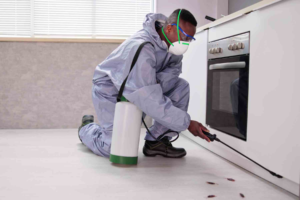Gutters are an essential part of a home’s water management system. They channel rainwater away from the building to prevent damage to the roof, walls, windows, and foundation.
Gutters must be properly pitched (angled) so water flows towards downspouts. The pitch should be about 1/4 inch of slope per 10 feet of gutter length. Visit Our Website to learn more.

The primary function of gutters is to channel rainwater away from your home, preventing it from pooling around the foundation. When your gutters are clogged, they can’t do this job and water may flow down the sides of the house, washing away dirt and even cracking the foundation. If left unattended, this can lead to expensive foundation repairs for your home.
A wet basement is one of the most common signs that your gutters are clogged. When water pools near the foundation of your home, it can seep into the basement walls and create cracks and leaks. Over time, these cracks can become larger and can cause your home’s foundation to shift.
In addition to wet basements, clogged gutters can also cause mold and insect infestations. Mosquitoes breed in standing water and rodents love to nest in debris, making clogged gutters the perfect environment for pests to call home. Pests like these can damage your gutters and roof, as well as penetrate the walls of your home.
One of the most obvious signs that your gutters are clogged is water spilling over the edges of your home during a rainstorm. This is a sure sign that the gutters are overflowing and need to be cleaned.
You can also tell if your gutters are clogged if they are sagging or appear crooked. This is because the clogs are adding extra weight to your gutter system, which can cause them to warp and sag.
If you notice plants sprouting inside of your gutters, this is a sure sign that the gutters have become clogged. The roots of these plants will grow into the trough and obstruct water from flowing through it properly. In addition, the plants can block sunlight from reaching your roof, causing it to rot and fall apart.
The most serious problem associated with clogged gutters is erosion. When water sits inside the trough, it will slowly wear away at the soil around your foundation. This can cause the soil to shift and can even cause your foundation to settle on one side of the house, leading to many other problems.
Clogged Downspouts Can Lead to Flooding
Gutter systems help to protect your home from water damage by siphoning rainwater and snow melt away from the house. It’s important that gutters and downspouts are properly maintained to avoid costly repairs and replacements. But clogged downspouts can lead to a variety of issues, including basement flooding, sagging gutters, and foundation problems. Here are some of the most common signs of downspouts that are clogged and need to be cleaned or repaired:
If you notice water leaking from the gutter outlet it usually means there is a clog in the downspout below it. This can be caused by a variety of things, including leaves, twigs, bird nests, pet toys, or even a fallen tree. Often times the clog is near one of the elbows in the downspout where debris tends to build up.
Another common sign of a downspout clog is the water pooling on the roof. This can cause serious damage to your roof and if it happens frequently, it may affect the structural integrity of the whole roof. In addition, if you notice water pooling around the house, it can cause soil erosion and cracks over time, which could weaken your foundation and lead to basement leaks.
Clogged downspouts can also strain the flashings that keep water and moisture out of joints between roof panels, and other architectural elements such as roof valleys. This can cause rust and other damage that could require costly repairs or replacements.
If you don’t regularly clean your gutters and downspouts, they may become clogged with leaves, twigs, pet toys, and other debris. Keeping them clean and free from obstructions is an easy way to prevent this and ensure they are working correctly.
To prevent clogs, install downspout extenders to move excess rainwater farther away from your foundation. This will lower the risk of basement flooding, soil erosion, and foundation problems. Other prevention techniques include trimming trees regularly to limit overhanging branches, which can cause sticks to fall into the gutters; and installing gutter covers that will reduce the amount of debris entering the gutters.
Clogged Gutters Can Damage Your Roof
One of the primary functions of gutters is to collect water and divert it away from your home. If your gutters are clogged, they will be unable to perform this function properly, leaving your roof vulnerable to damage.
When rainwater isn’t able to evacuate your roof, it will begin to build up and leak over the sides of the gutter. This water can then seep into your walls and ceilings, causing moisture damage and mold. The resulting damage can be costly and difficult to clean up.
Clogged gutters can also cause structural damage to your home’s fascia boards and soffit. The accumulated water can cause the wood to rot, which can affect the integrity of the entire structure. This can lead to sagging or warping of the fascia board, and may eventually cause it to fall off completely.
A clogged gutter can also damage the shingles on your roof. When the water can’t be evacuated, it will sit on the shingles and cause them to wear down or break apart. In addition, the shingle edges will become corroded from the moisture.
Another sign of a clogged gutter is the appearance of water spots or stains on your home’s siding. If you notice these stains, it’s important to contact your local handyman right away to schedule a gutter cleaning service.
Clogged gutters can also be a breeding ground for insects and pests. The wet gunk and debris in your gutter can attract mosquitoes, ants, termites, carpenter bees, and more. These pests can then move on to your home, where they will cause further damage.
In the winter, clogged gutters can also cause an ice dam. When snow begins to melt on your roof, the melted water needs somewhere to go. If the water isn’t able to drain away from your gutter, it will start to freeze over and form an ice dam that can cause more water leaks into your home.
While it’s possible for a homeowner to perform some maintenance tasks on their own, there is always a limit to what can be done. If you notice signs of a clogged gutter or have questions about other projects around your home, it’s best to call your local handyman right away for help.
Clogged Gutters Can Damage Your Siding
The gutter system is not just an aesthetic feature of the roofline. It is designed to direct rainwater away from the foundation of your home and into landscape drainage systems so that soil erosion does not occur. Water pooling around the foundation of a home can cause cracks over time, which can be dangerous and costly to fix. Gutters that are clogged can’t do their job and the overflowing water can damage siding, windows, shingle edges and the fascia boards that hold them in place.
One of the most common signs that your gutters are clogged is water stains on the siding of your home. This is a sign that the overflowing rainwater is soaking the wood of your home, causing unsightly stains and making the home less attractive. A clogged gutter also creates the perfect environment for mold and mildew, which can lead to serious health problems for your family.
Another common sign of clogged gutters is plant growth inside the gutters. This is a clear indication that the gutters need to be cleaned out. The seeds of various plants can collect inside the gutters along with dirt and debris, creating a “gutter garden.” If left unattended, this can result in the deterioration of the gutters, downspouts and the surrounding landscaping.
In addition to plant growth, clogged gutters can be overrun by pests. Insects, birds and rodents love the warmth and moisture that a clogged gutter provides, and can invade your home and damage the siding, roof and foundation. The best way to avoid these issues is to keep your gutters clean and properly sized for your home.
The first sign of clogged gutters is water spilling over the sides of the gutters during a rainstorm. This overflowing water isn’t just ugly; it can also rot the fascia board and shingle edges and damage the paint on your house. In addition, the rushing water can erode soil near the foundation of your home and cause cracks in the basement walls or other structural problems that are expensive to fix. The best way to prevent this is by cleaning your gutters regularly and replacing the downspout cage when needed.








